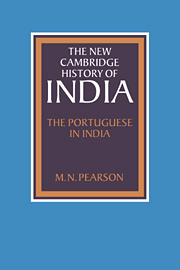Crossref Citations
This Book has been
cited by the following publications. This list is generated based on data provided by Crossref.
Rubiés, Joan‐Pau
1993.
New worlds and renaissance ethnology1.
History and Anthropology,
Vol. 6,
Issue. 2-3,
p.
157.
Hair, P. E. H.
2002.
Before Vasco da Gama.
Bulletin of Spanish Studies,
Vol. 79,
Issue. 1,
p.
54.
Henn, Alexander
2006.
Rites hindous.
p.
31.
2006.
A Companion to the Reformation World.
p.
506.
Županov, Ines G.
2006.
A Companion to the Reformation World.
p.
353.
MOORE, JASON W.
2010.
‘Amsterdam is Standing on Norway’
Part I: The Alchemy of Capital, Empire and Nature in the Diaspora of Silver, 1545–1648.
Journal of Agrarian Change,
Vol. 10,
Issue. 1,
p.
33.
García-Fernández, Miguel
2012.
Alfabetización, autoría e produción impresa. Unha aproximación en feminino á cultura letrada da Galicia moderna.
Cuadernos de Estudios Gallegos,
Vol. 59,
Issue. 125,
p.
193.
Prasad, Pavithra
2015.
Paradiso Lost: Writing Memory and Nostalgia in the Post-Ethnographic Present.
Text and Performance Quarterly,
Vol. 35,
Issue. 2-3,
p.
202.
Henn, Alexander
2015.
Kristapurāṇa: Translating the Name of God in Early Modern Goa.
South Asia Multidisciplinary Academic Journal,
de Figueiredo, John M.
2015.
On the resilience of bicultural exchange under prolonged and persistent acculturative stress: implications for the study of demoralization.
International Journal of Culture and Mental Health,
Vol. 8,
Issue. 1,
p.
79.
Mason, Paul M.
2016.
Two 17th-century English factories in North Kanara, Karnataka, India: a historical archaeology perspective.
Post-Medieval Archaeology,
Vol. 50,
Issue. 2,
p.
227.
Moore, Jason W.
2017.
The Capitalocene, Part I: on the nature and origins of our ecological crisis.
The Journal of Peasant Studies,
Vol. 44,
Issue. 3,
p.
594.
Morrison, Kathleen D.
2018.
Globalization in Prehistory.
p.
283.
Walker, Timothy D.
2021.
Contesting Sacred Space in the Estado da India: Asserting Cultural Dominance over Religious Sites in Goa.
Ler História,
p.
111.
Subrahmanyam, Sanjay
2021.
‘Should auld acquaintance be forgot’: On the Portuguese Empire in Asia, 1500-1700.
Ler História,
p.
265.
Rodrigues, Sanchia Danielle Coutinho
2021.
Colonialism, communication and cultural politics: language and the reproduction of caste and class privilege in Goa, India.
Asian Englishes,
Vol. 23,
Issue. 3,
p.
251.
Sail, Smita
and
Priya, M.G.
2023.
The Role of Purity and Pollution Rituals in Religious Conversions of Goa During Portuguese Colonization: A Probe Through Select Goan Novels.
Interventions,
Vol. 25,
Issue. 6,
p.
756.





